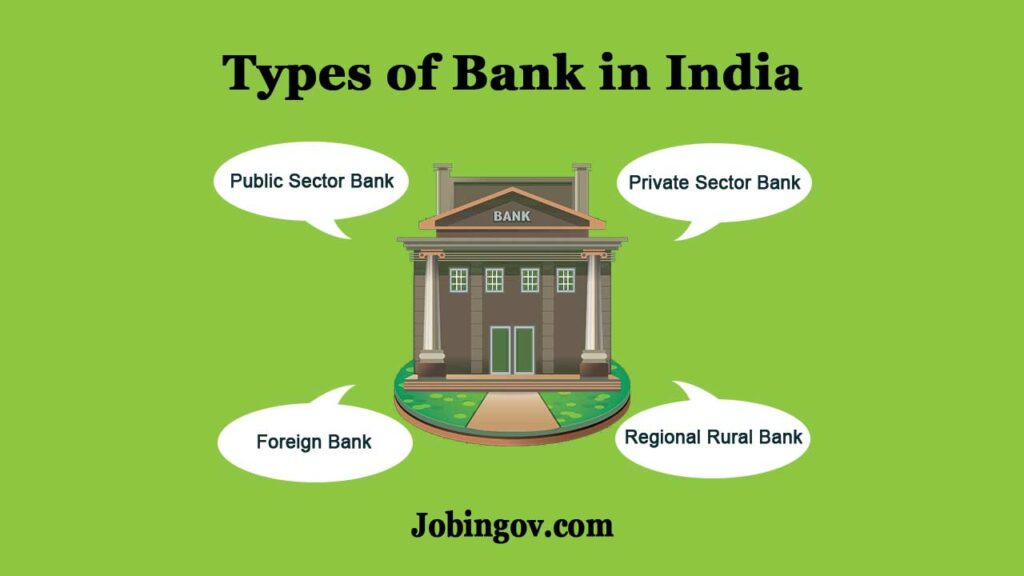Types of Banks in India: A bank is a financial institution where deposit and lending of funds are allowed. Banks are considered as the backbone of any country.
RBI is the central banking body of India and is responsible for regulation and control of banks across India.

Classification of Bank in India
Banks in India are broadly classified into two categories such as
- SCHEDULED BANKS
- NON-SCHEDULED BANKS
Also Read: Types of Bank Account in India 2023
Scheduled Banks
Any bank i.e. under the second schedule of the RBI act, 1934. Reserves of the bank should be at least 50 lakhs. The bank has to maintain CRAR (Capital to Risk Weighted Assets Ratio) as per RBI. It should work for the interest of the depositor.
Scheduled Banks are further classified into Commercial Banks and Cooperative Banks. In the commercial banks REGIONAL RURAL BANKS, SMALL FINANCE BANK, FOREIGN BANKS, PRIVATE SECTOR BANKS, and PUBLIC SECTOR BANKS are included. New bank added in this category is Payment Bank.
The bank consists in Commercial Banks are Urban Bank and Rural Bank.
Here we will briefly discuss about different types of scheduled banks.
Commercial Banks
This type of banks are generally set up for business purposes and profit making. These banks are regulated and controlled under the banking regulation act, 1949. Their main purpose and function is to lend loans to the government, general public, and corporate as well as accept deposits.
Commercial banks are mainly four types:
- Public Sector Bank
- Private Sector Bank
- Foreign Bank
- Regional Rural Bank
Full Form of All Banking Related Terms
1. Public Sector Bank
Almost 75% of banks of the nation is for business purpose. These are called nationalized banks. Public sector banks were nationalized under either Banking Nationalization Act, 1969 and under the Banking Nationalization Act 1980.
The largest public sector bank is SBI by volume when it merges with the other associates. If you check the top 50 list banks of the world, SBI is one of them.
In India, there are 19 nationalized banks, SBI & Associates, IDBI Bank presently. These are:
- SBI & Associates
- IDBI Bank
- Bank of India
- Bank of Maharashtra
- Bank of Baroda
- Allahabad Bank
- Andhra Bank
- Canara Bank
- Central Bank of India
- Corporation Bank
- Dena Bank
- Indian Overseas Bank
- Indian Bank
- Oriental Bank of Commerce
- Punjab National Bank
- Punjab & Sind Bank
- Syndicate Bank
- Union Bank of India
- United Bank of India
- UCO Bank
- Vijaya Bank
2. Private Sector Bank
Major portions stakes of private sector banks are gained by private shareholders. These banks are controlled and regulated by Reserve Bank of India (RBI).
There were 13 banks before 1993 and after that 9 new banks established by the recommendation of Narasimham committee.
The names of the private sector banks are given below:
- Axis Bank
- Bandhan Bank
- Catholic Syrian Bank
- City Union Bank
- DCB Bank
- Dhanalaxmi Bank
- Federal Bank
- HDFC Bank
- ICICI Bank
- IDFC Bank
- Indusind Bank
- Jammu & Kashmir Bank
- Kotak Mahindra Bank
- Karnataka Bank
- Karur Vysya Bank
- Lakshmi Vilas Bank
- Nainital Bank
- RBL Bank
- South Indian Bank
- Tamilnad Mercantile Bank
- Yes Bank
3. Foreign Bank
This kind of banks are operated in India but majority of shareholders are foreigners as well as headquarter is in outside India. Foreign Banks are controlled & regulated by both the country in which it is situated as well as in that country where it’s headquarter is.
A foreign bank has to maintain CAR, CRR and SLR. Minimum 5 billion capitals are required. Foreign Banks has 74% of FDI (Foreign Direct Investment). Maintain a minimum of 40% PSL (Primary Sector Lending). Some foreign banks in India are:
- CITI BANK
- STANDARD CHARTERED BANK
- HSBC BANK
4. Regional Rural Bank (RRBs)
Regional Rural Bank (RRBs) were established on the recommendation of Narsiman Committee through RRB Act 1975 which was passed in 1976, October 02.
The main purpose of RRB was to allot funds to the weaker sections of the people at concessional rate and channelize the savings of rural in productive activities which are conducted in rural areas.
The first RRB was Prathama Bank in Moradabad which was sponsored by Syndicate bank. At present there are 56 RRBs in India as on 31st March, 2019 with 21840 branches. It should be noted that there is no RRB in Goa and Sikkim.
The percentage of shareholding in RRBs is Govt (50%), State Govt (15%) and Sponsored bank (35%).
Small Finance Banks
- It must be a private bank.
- The entity must have experience of banking for 10 years.
- Deposits as well as loan products will be provided through small banks.
- For this type of banks minimum Rs. 100 crore is required to start operate as small banks.
- Foreign shareholding is allowed as per Foreign Direct Investment (FDI) norms for private banks i.e. 74%.
- Small banks are established on the recommendation of Usha Thorat Committee.
- The aspects of this bank is to facilitates banking facilities in Unbanked Rural Areas and 25% of total branches of small banks must be in that areas.
- Small Finance Banks is bounded to provide 75% of their total funds to priority sectors.
- Till now license is given to 10 entities and out of them 8 has started to work as small bank.
- These banks are regulated by RBI and FEMA.
The name of these banks are:
- AU SMALL FINANCE BANK
- CAPITAL SMALL FINANCE BANK
- FINCARE SMALL FINANCE BANK
- EQUITAS SMALL FINANCE BANK
- ESAF SMALL FINANCE BANK
- SURYODAY SMALL FINANCE BANK
- UJJIVAN SMALL FINANCE BANK
- UTKARSH SMALL FINANCE BANK
- NORTHEAST SMALL FINANCE BANK
- JANA SMALL FINANCE BANK
Payment Bank
- In Payment Bank majority stake holders are private. So, it is a private bank.
- Payment Banks are allowed to open Demand Deposit (Current Account & Saving Account) but doesn’t allowed to open Time Deposit (Recurring Account & Fixed Deposit Account).
- Maximum balance in a payment bank account can be up to Rs. 1 Lakh per customer.
- Payment bank doesn’t lend any kind of loan to its customers.
- Customers can have benefits of Debit cards (ATM card) but not of Credit cards.
- To open this kind of bank minimum Rs. 100 crore capital is required.
- Main thought behind this kind of bank is to provide all the banking facilities in remote rural areas. So, it must covered 25% of the total payment banks in the Unbanked Rural Areas.
- As per Foreign Direct Investment (FDI) rules for private bank, foreign shareholding is allowed in payment banks i.e. maximum 74% of FDI is allowed.
- Payment Bank is established on the recommendation of Nachiket Mor.
- There are a total of 11 entities which have got license and out of these 4 open banks, 3 banks have stopped to work as payment bank and rest 4 will start functioning as payment banks.
The payment banks in India are:
- Aditya Birla NUVO
- Airtel M Commerce Services
- Cholamandalam Distribution Services
- Department of Posts
- FINO PayTech
- National Securities Depository
- Reliance Industries
- Sun Pharmaceuticals
- Paytm
- Tech Mahindra
- Vodafone M-PESA
Cooperative Bank
Any bank is a cooperative if the customer is owner, account holder, lender, borrower.
Cooperative bank was registered under cooperative societies act, 1912 and are governed by banking regulation act 1949 and Banking Laws (Cooperative Societies) Act, 1965. These banks are regulated by RBI (Reserve Bank of India).
Cooperative bank was established to meet financial support in rural areas. The minimum capital required to open cooperative bank is Rs. 500 crore.
These banks are organized according to 3 tier structure
- State Level (Tier I)
- District Level (Tier II)
- Village Level (Tier III)
Also Read: Indian Financial System 2023
Sample Questions for Government Exams
Q1. What is the minimum capital required to open a payment bank?
- 150 Crore
- 300 Crore
- 100 Crore
- 500 Crore
Answer: Option (3)
Q2. What is the minimum paid-up amount for small finance bank?
- 250 Crore
- 50 Crore
- 100 Crore
- 200 Crore
Answer: Option (3)
Q3. How much fund must a Small Finance Bank provided to priority sector lending (PSL)?
- 50%
- 75%
- 60%
- 40%
Answer: option (2)
Q4. A Customer is allowed to deposit of up to Rs _______ in Payment Bank?
- 2 lakhs
- 1 Lakh
- 5 Lakhs
- 10 Lakhs
Answer: Option (2)
Hopefully this article will help you to get an idea about types of banks in India. Also, you can join us on Facebook to get more latest update.
Frequently Asked Questions
Q1. Why SBI Bank is not nationalize?
Ans: SBI Bank is not nationalized because it has a different Act that is SBI Act 1955 and it was not nationalize either in Banking Nationalization Act, 1969 or in 1980.
Q2. Mention the name of some Public Sector Banks?
Ans: Bank of India, Bank of Maharashtra, Bank of Baroda, Allahabad Bank, Andhra Bank are Public Sector Banks.
Q3. Commercial Banks are regulated by which act?
Ans: Commercial Banks are regulated by Banking Regulation Act, 1949.





